http://crochet247.com/tag/lion-brand-shawl-in-a-ball-crochet-patterns/ 2 May 2020
disarmingly Numerous containers have been posted on blogs and on the Voynich.ninja forum to try to find a match for the simple and lavish containers in the VMS small-plants section. Some have suggested the VMS containers are microscopes, or telescopes. To me they look like pigment tubes, reading tubes, needle tubes, and spice containers. I’ve collected thousands of images of containers but it’s difficult to find ones that are highly ornate that are similar to the VMS drawings that were created before 1460.
I’ve previously blogged about some of the history and designs of containers. This time I’d like to post some images that are found on playing cards and manuscript illustrations from the 14th to 16th centuries.
The Popular Pastime
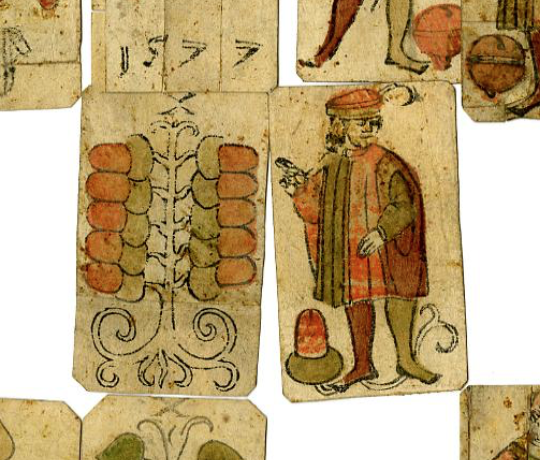
Playing cards were very popular in the 15th century despite some social stigmas attached to cards and gambling. Some intriguing imagery in tarot cards has already been noted by VMS researchers.
In addition to tarot designs, playing cards included religious imagery, fashions, zodiac themes, trees in the style of virtues and vices (see right), notable figures, and… fancy containers.
Below is an example of an uncut sheet of playing cards from the Lower Rhine, created about 1470. These lidded chalices were drawn in a variety of styles and some have interesting fluted or hexagonal bases. Some of the patterns spiral around the container, a pattern that would be difficult to fabricate in the 15th century, others have ornate textural overlaps:
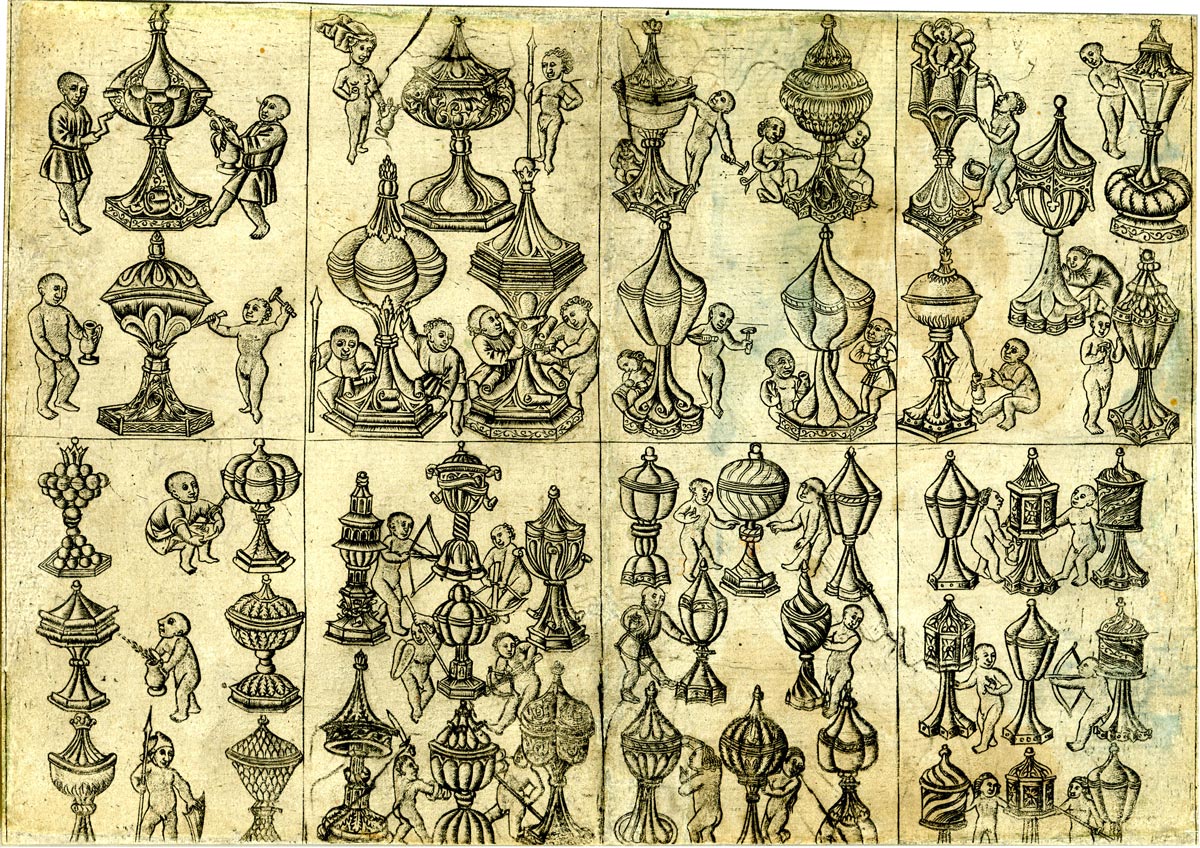
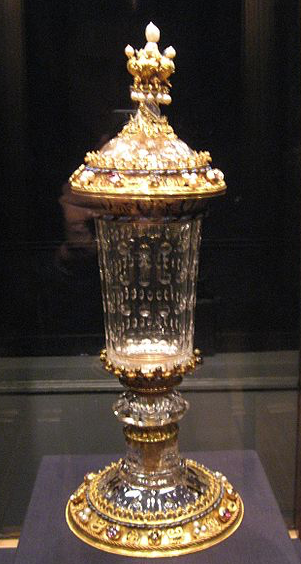
The chalices in the above drawings appear to be mostly metal, but containers made with gemstones and glass did exist in the 15th century. Jasper was a popular material, but there were also some transparent chalices made from rock crystal or glass, like this elegant chalice from the Burgundian court (right), dating from about the 1450s or 1460s.
Most of the lidded chalices on playing cards probably didn’t exist in real life. They would have been too expensive for most people to afford, even the nobility. There are some luxury goblets from Spain, Italy, and Austria that have survived from the latter 1300s that are similar to the Burgundy Court chalice, but they are not numerous, and some of the more ornate designs exist only as manuscript illustrations.
There are a few examples of chalices and urns carved from ivory or which use an ostrich egg for the central container, but most of them are later than the 15th century. For those on leaner budgets, copper was sometimes substituted for gold and silver, but even these were out of financial reach for the average person.
Some of the most ornate metal chalices of the 1450s were created in Hungary, but most of them did not include glass. Ornate enameling was sometimes inserted in the spaces between raised designs.
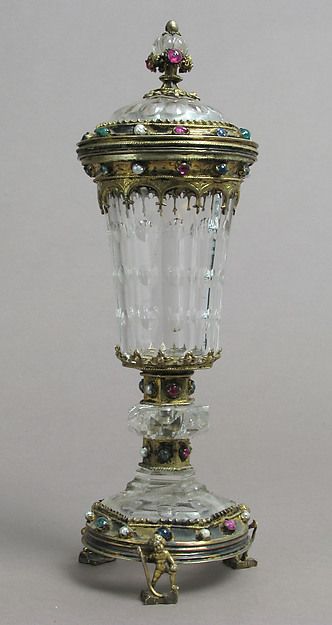
On the left is a 15th-century German chalice similar to the Burgundian Court chalice (note the shape and position of the glass elements). Many of these luxury containers were studded with gemstones.
It’s possible that some of the fancier designs depicted on playing cards in the mid-15th century ended up in the collections of kings later in the 15th century or 16th century, when technology improved enough to fabricate more efficiently.
I sometimes wonder if some of the VMS containers were concept designs rather than actual containers. Some of them could have existed in the early 15th century but others would have been difficult or impossible to make, depending on how much glass was involved. There is at least one VMS container that looks like it might be transparent.
The Flemish painting below includes an ornate chalice very much like the Burgundian Court chalice. It’s a little smaller, and doesn’t have glass in the foot, but it’s the same general idea:
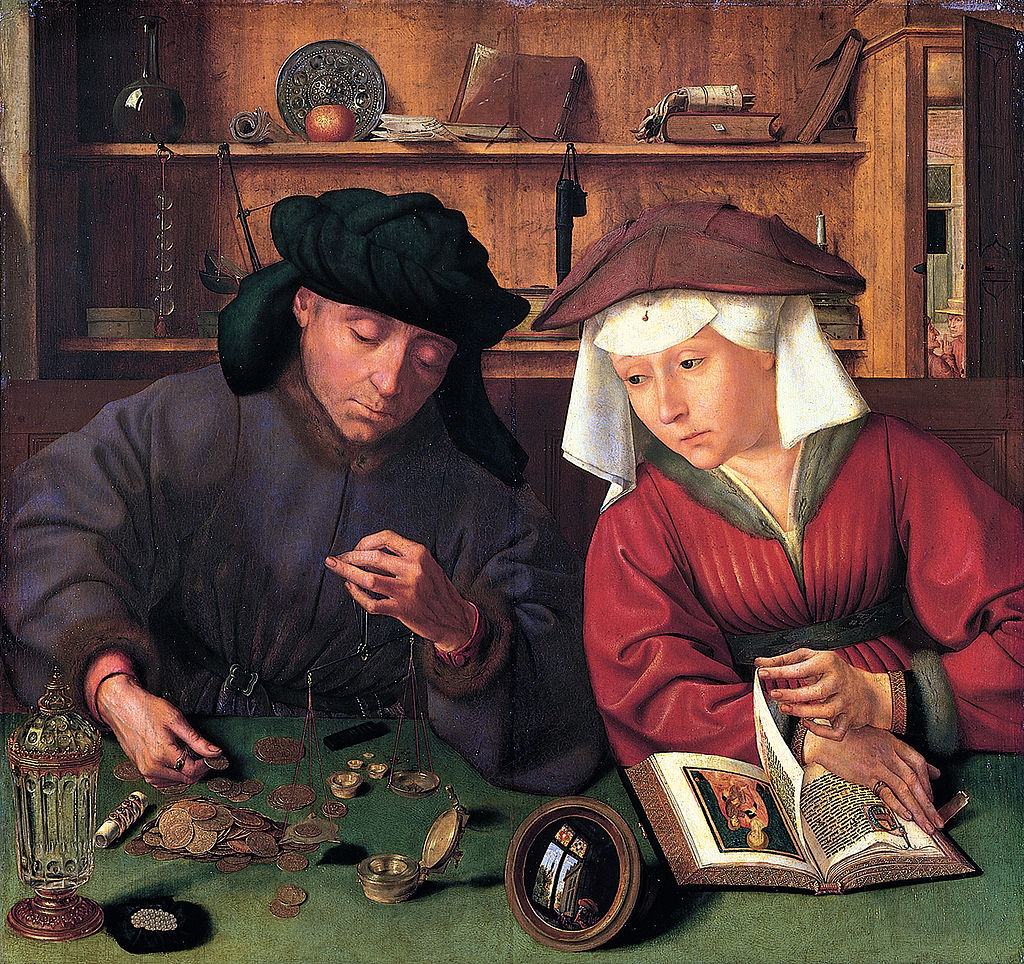
The chalice below is unusually ornate for its time. It is dated to the first half of the 13th century, created for a monastery near Freiburg im Breisgau, possibly for the celebration of Eucharist. Some of the Portuguese cibora from this time period are also highly ornate, but in a different style (more enamel and less filigree):
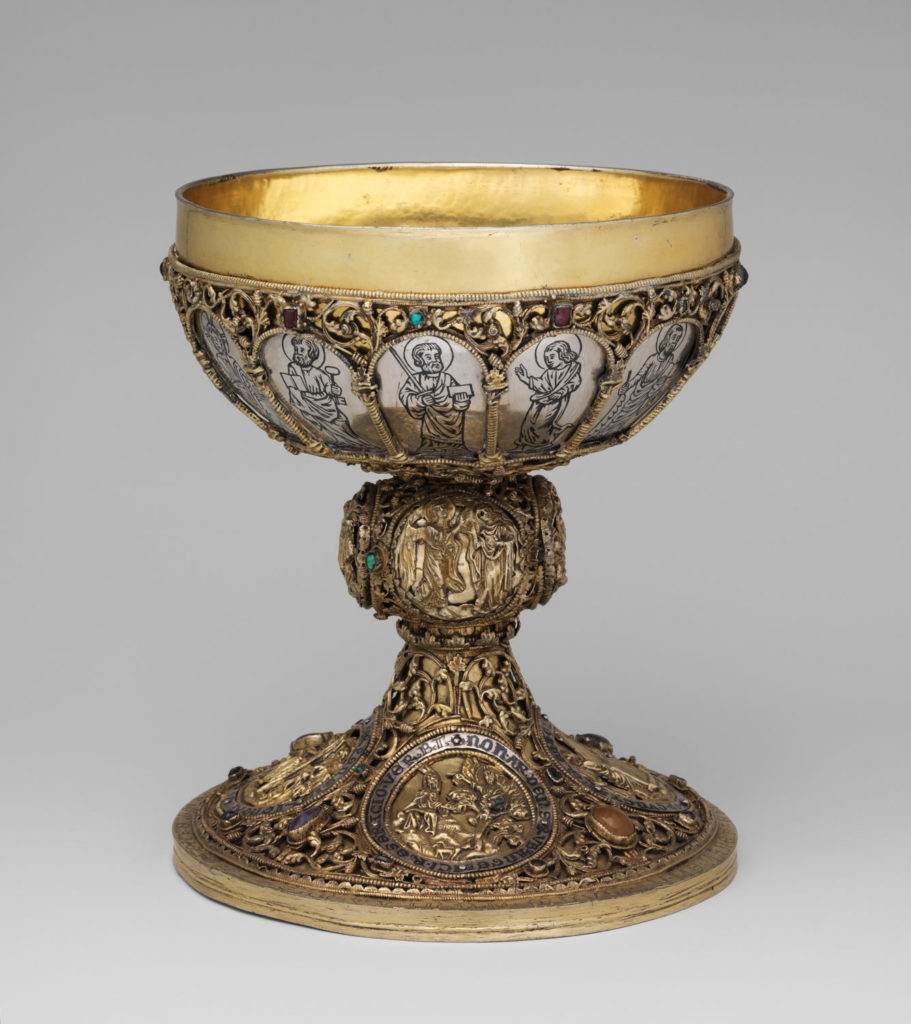
Container Illuminations
It is easier to draw a chalice than to build one so we don’t always know whether the containers in manuscript illuminations were real or existed only in the imagination of the illustrator.
This Viennese painting of the presentation of Jesus to the Three Wise Men (below) probably depicts containers that were a little more ornate than most of the containers one would find in real life in the 1460s:
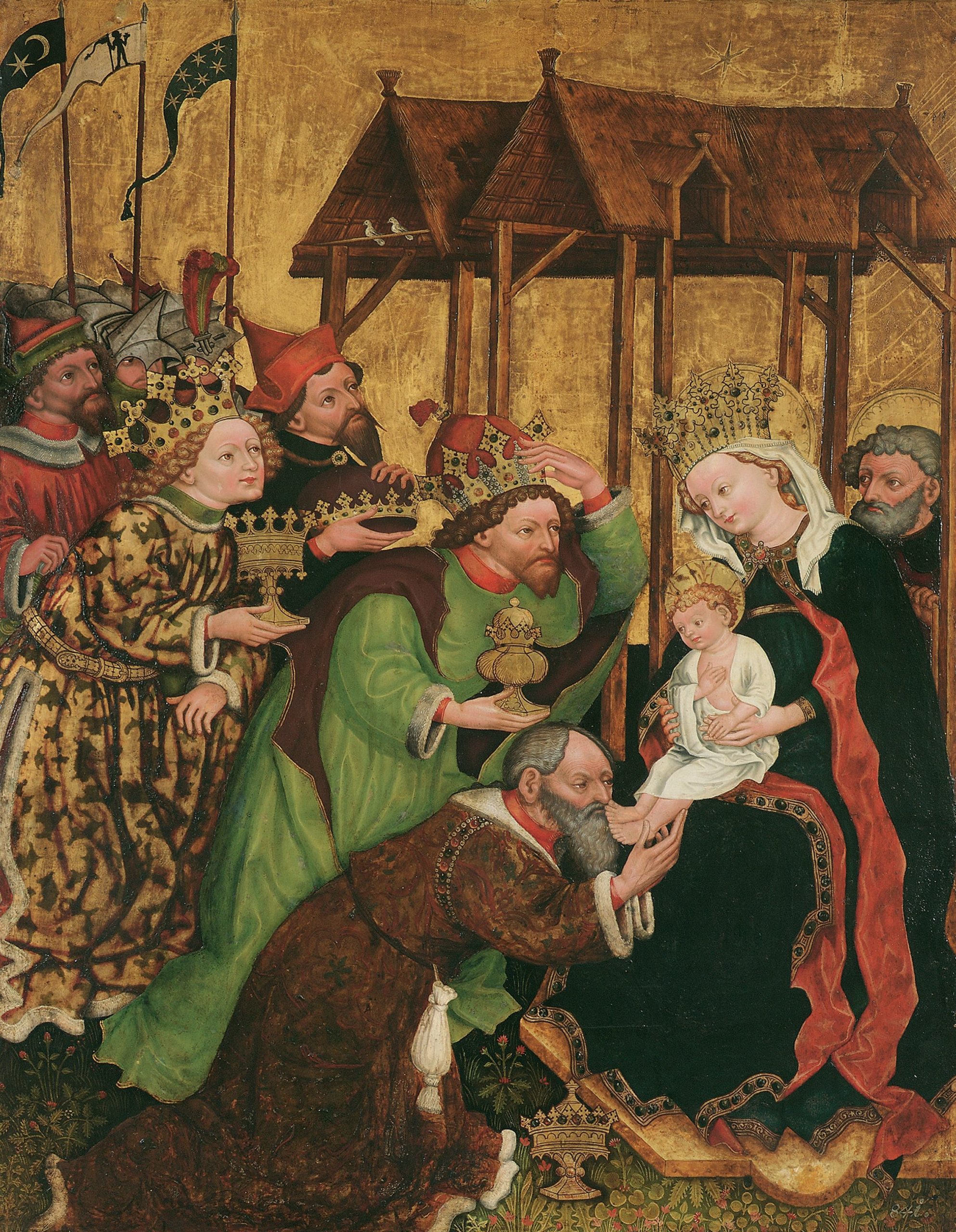
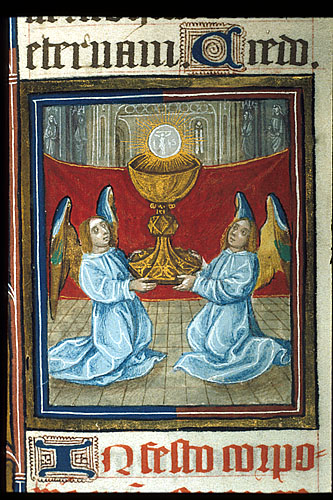
Fancy chalices are often included in illustrations of the Eucharist or Three Wise Men.
On the right are two angels holding a chalice that has been enlarged to indicate its importance. The exaggerated size makes it possible for us to see the detailing on the foot (BL Royal 2B XIII).
Luxury lidded chalices were often drawn with a wide middle and narrow, fancy finials. In the example below are two fancy chalices and a more utilitarian container on the right, similar to an arbarello:
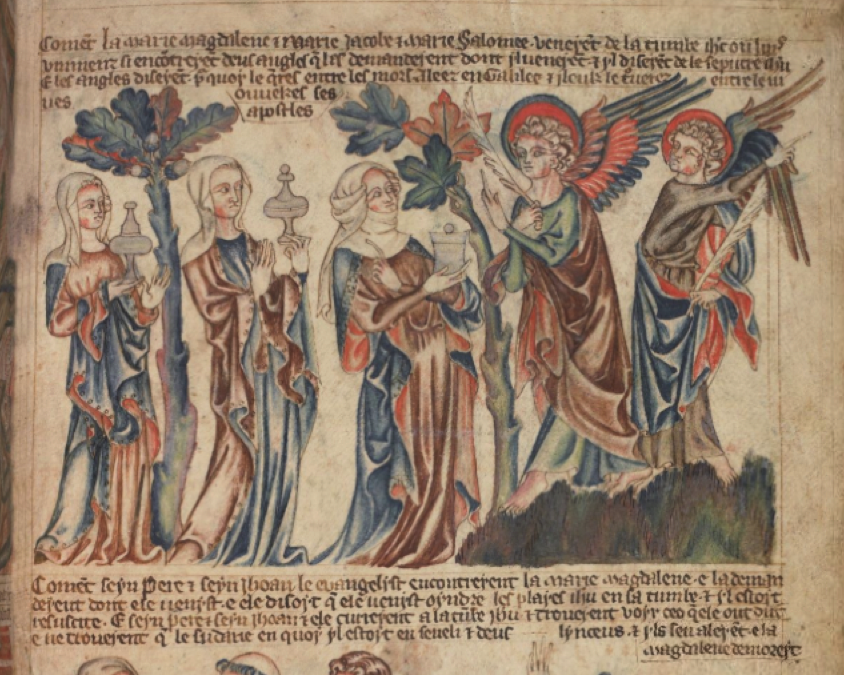
Here are three chalices from a Dutch Book of Hours. One is open to show the contents:
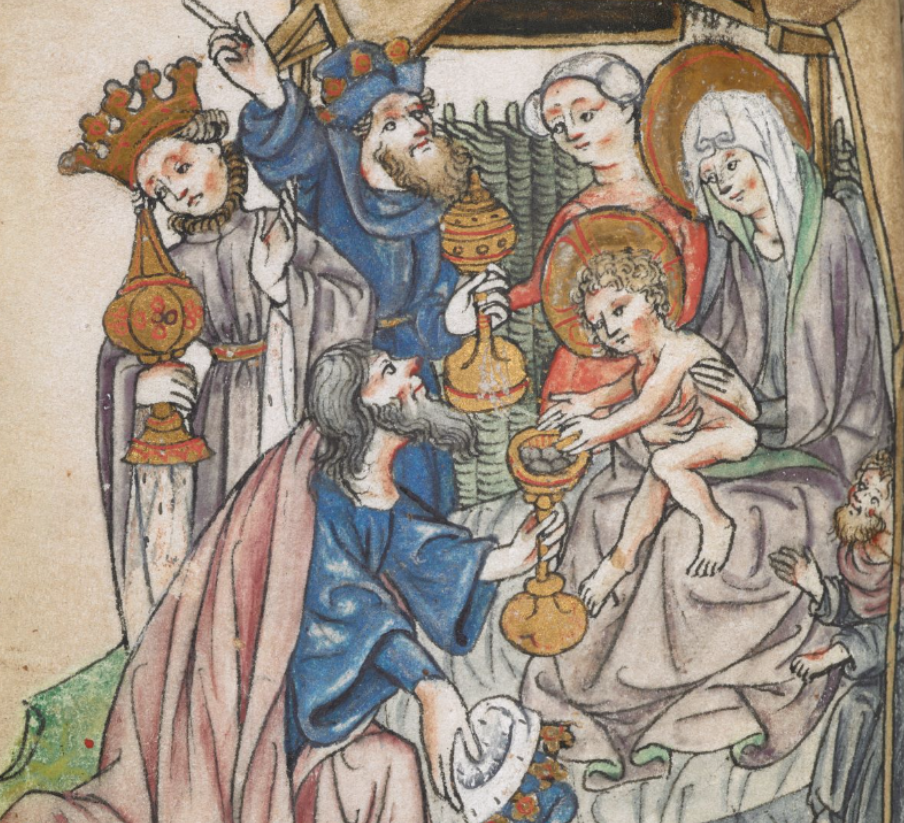
A very fancy spice tower or monstrance is included as an offering in a scene with VMS-style clothing (note the baggy sleeves):
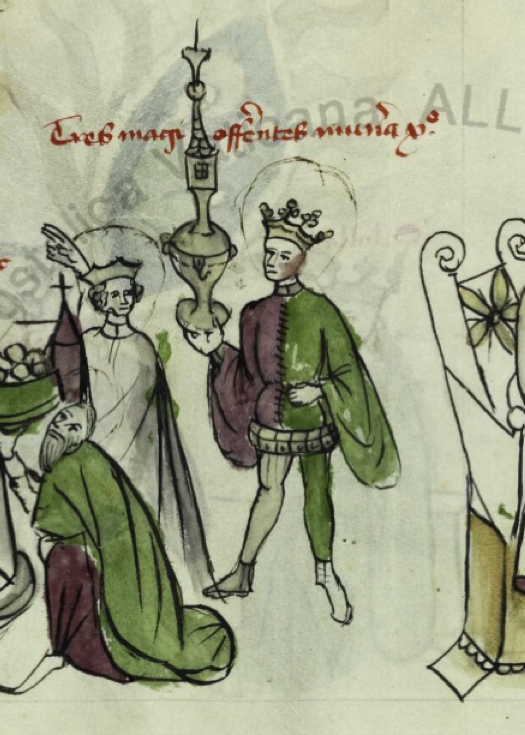
This French manuscript includes some highly ornate containers being offered by the Three Wise Men. They are drawn as metal containers, but the one on the right is designed like a Christian monstrance. A monstrance would sometimes have glass in the windows:
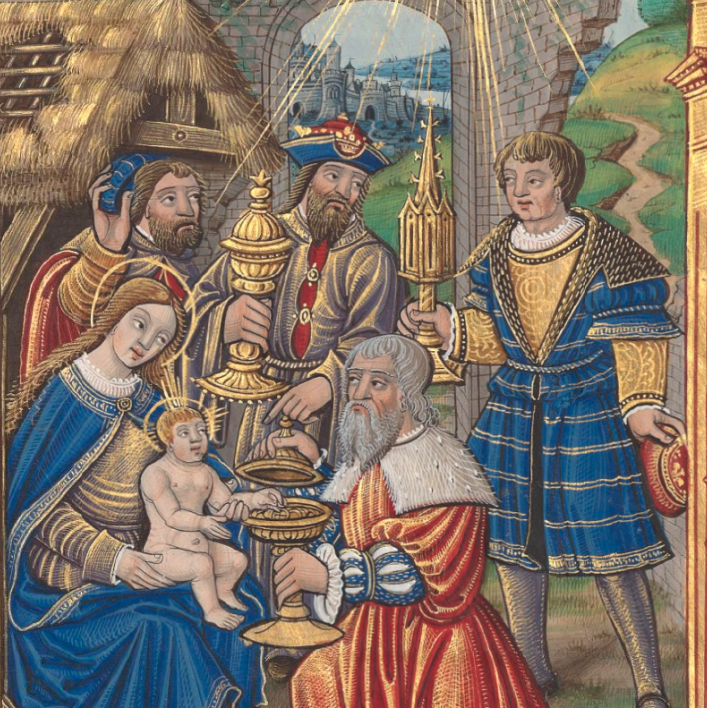
Here is an example of a reliquary shaped like a spice house in a Rhenish copy of Tacuinum sanitatis. The central portion is glass so the relic can be seen:
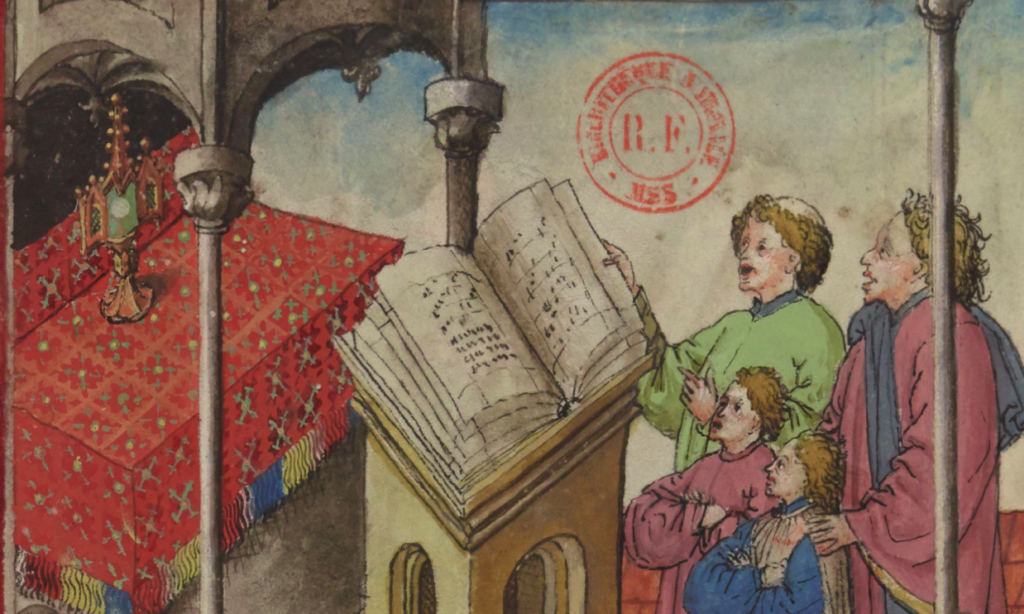
An elegant set of tableware in a French manuscript:
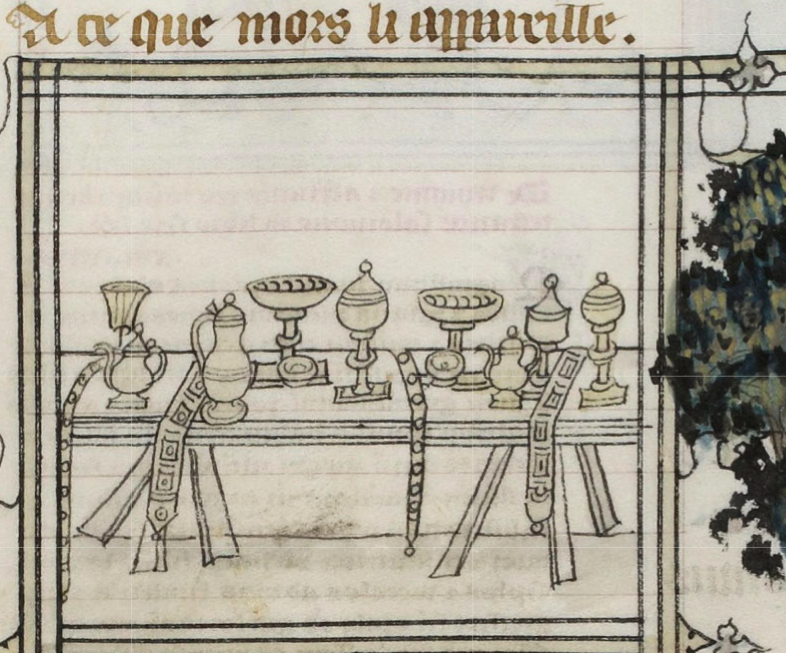
Hebrew codexes often have very beautiful ornate container designs. These illustrations are in a manuscript that includes both Sephardic and Ashkenazic scripts:
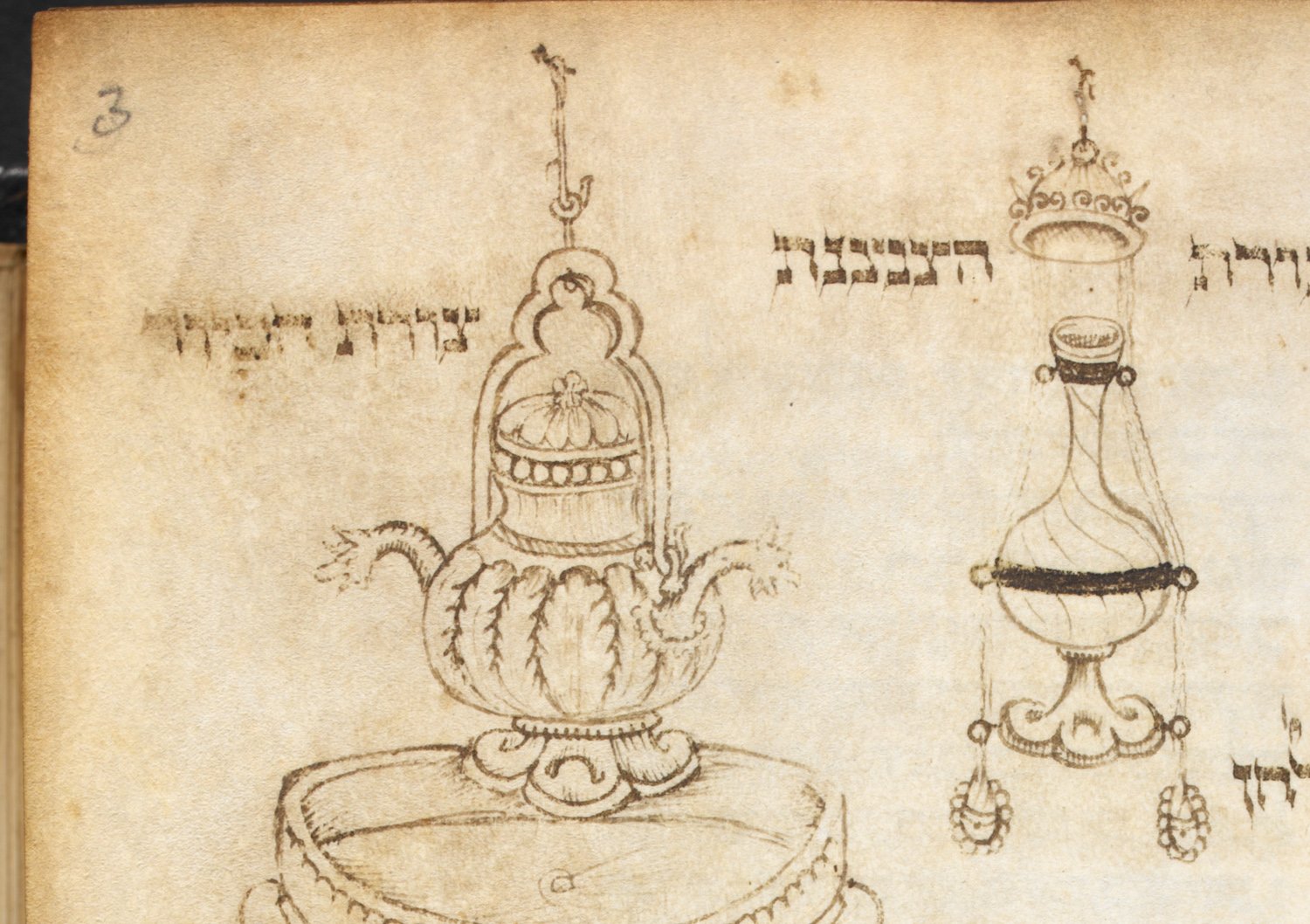
This illustrates a shop in Norwich, England, with a variety of pitchers, plates, and lidded chalices:
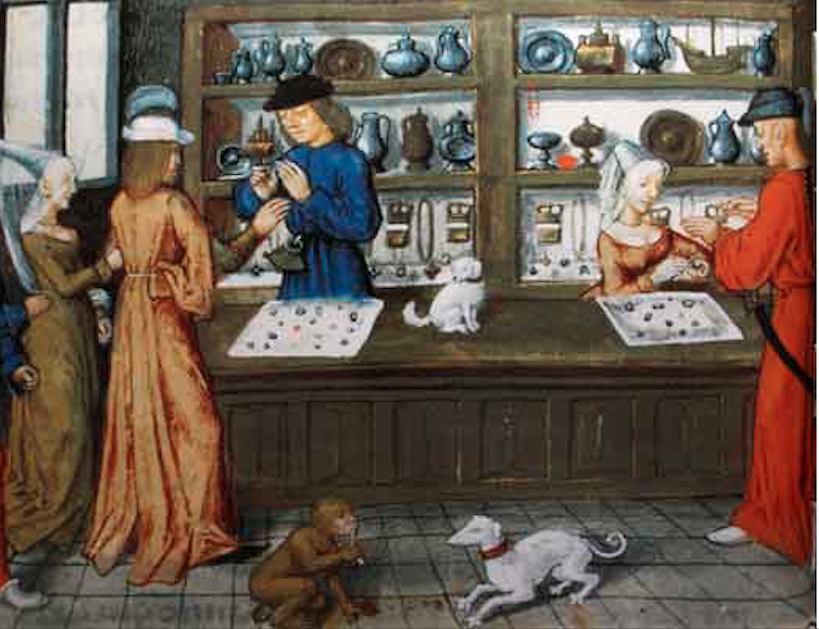
The following illustration from Genoa, Italy, includes fancy containers in a banking quarter, presumably items that have been pawned. Note the Ghibelline merlons across the top of the building. On the table are coins, with the owner, accountant, or clerk marking a register on the left. The hand gestures probably indicate a barter transaction for deciding the value of the items in the man’s hand.
In the background are a large lidded chalice and an ornate metal pitcher, probably studded with gemstones. The illustration is not strictly literal. It depicts the vice of avarice:
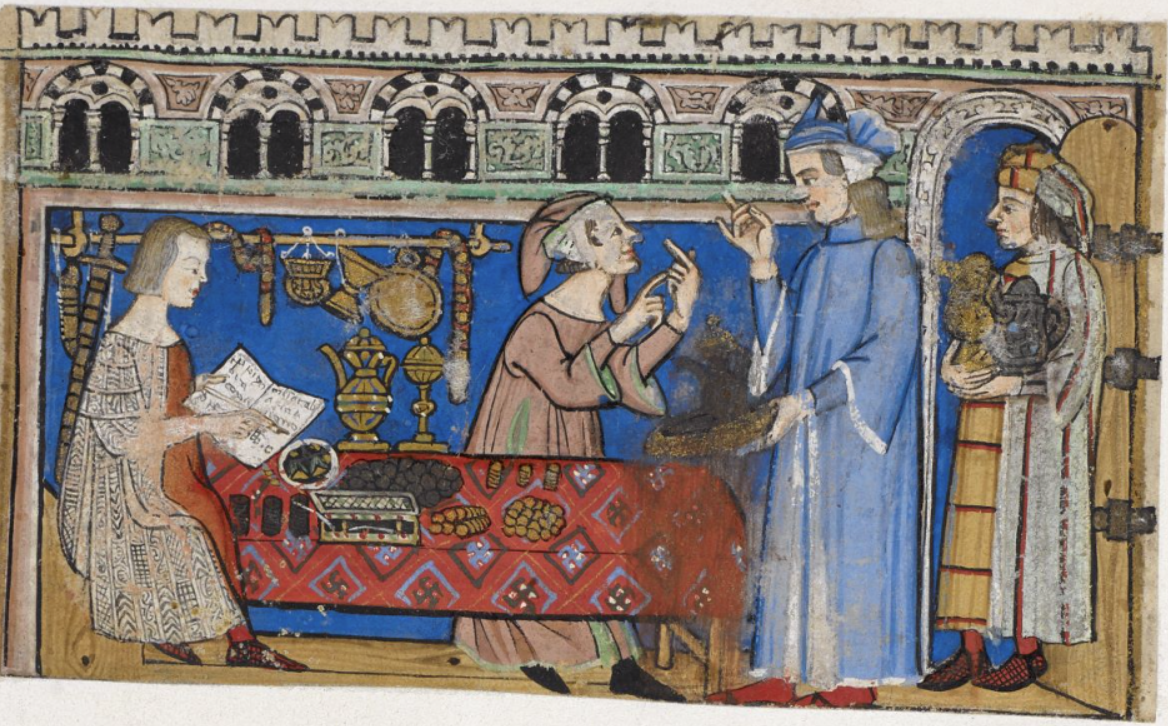
Chalices are not always associated with religious imagery, pawnshops or metal shops. Sometimes they are included in travelogues and novels. This is from the Romance of Alexander, from c. 1400, with participants in a feast being served food and drink from fancy containers:
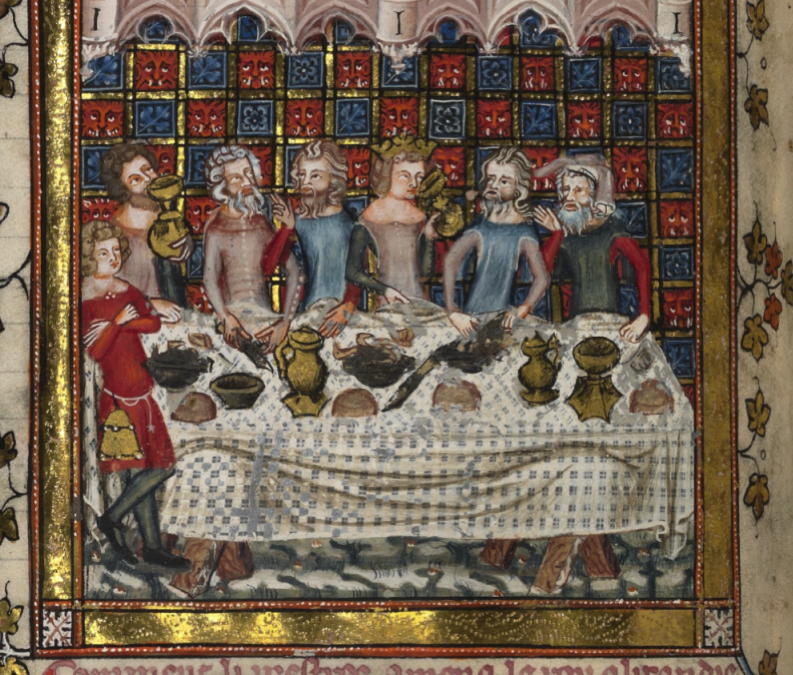
This elaborate lidded container is from a medieval book of medicine:
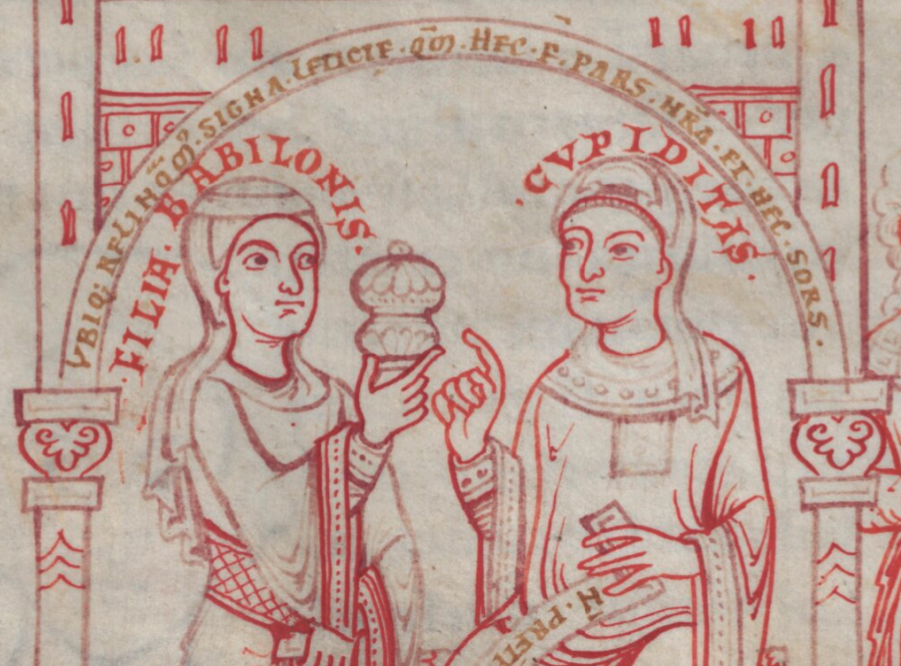
Are There Glass Containers?
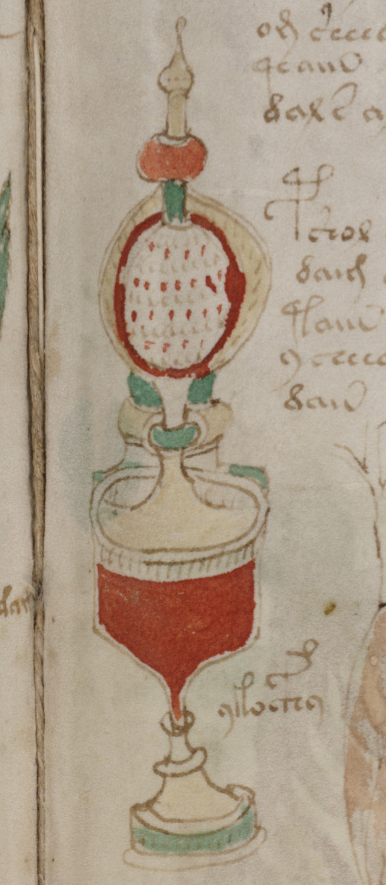
The VMS containers don’t appear to be studded with gems, and they probably don’t have filigree. They range from simple tubes that could be wood, metal, or leather, to cibora-like containers that are possibly metal. The fancy container on f89r might be partially or wholly made of glass. Regardless of whether the containers are real or conceptual, they aren’t necessarily all made of the same materials.
As mentioned in the previous blog, by the year 1500 containers similar to the VMS “fancy” container were being crafted in various parts of Bohemia, with northern Bohemian craftsmen having close ties to those in Italy.
The lidded examples below are from the Veneto. They are not quite the same shape as the VMS container, but they do have some traits in common, especially the finial and rounded foot:
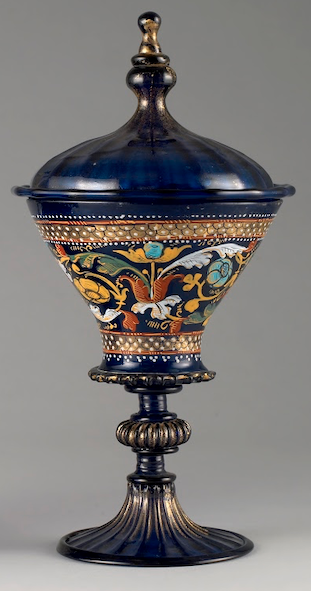
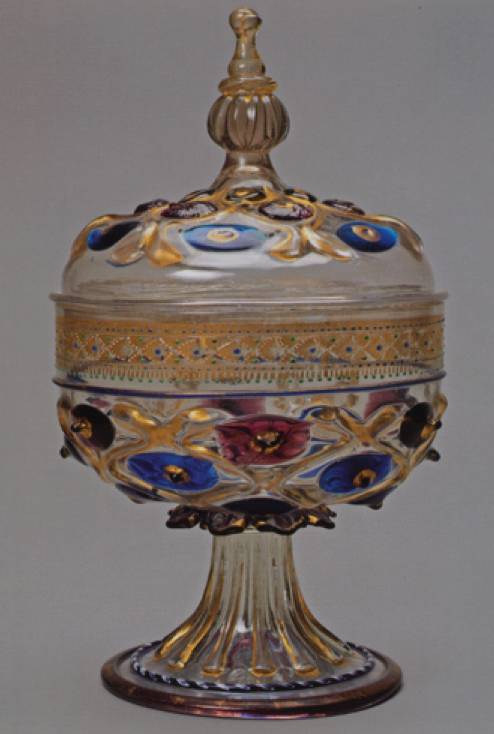
The Simpler Containers
In the Middle Ages, simple tubes were often crafted of leather or wood. Sometimes they were carved from bone. More ornate ones were usually made of copper, tin, silver, gold, or exotic materials like ostrich egg or ivory. Decorative curved glass was not common before the 1470s.
One container that differs substantially from the previous drawings is this leather scroll case. It’s like a larger version of a quill-pen case. Some were plain, others beautifully tooled like this one:
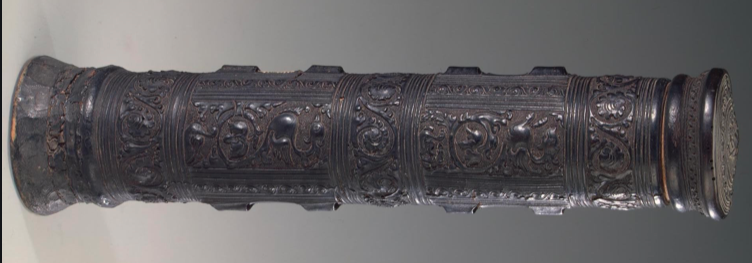
Roman scroll cases were sometimes made of bronze. Some of the middle eastern scroll cases were finely detailed metal. Not all scroll cases were a full tube. Some were simple caps, to protect the ends of the scroll.
Needle cases were similar to scroll cases, but smaller.
Swivel guns were bigger (15th c German, courtesy of Lennart Viebahn):
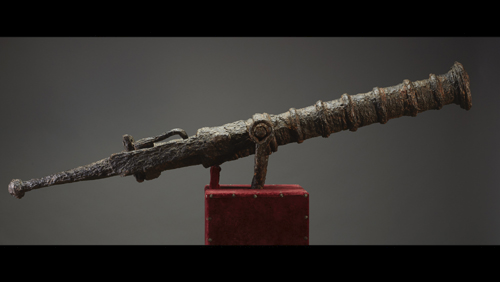
Seige guns were much bigger. These Turkish guns were built sometime around the late 1450s:

The siege guns actually look more like some of the “pipe” segments in the VMS pool drawings, but the naval swivel guns are vaguely like the VMS containers.
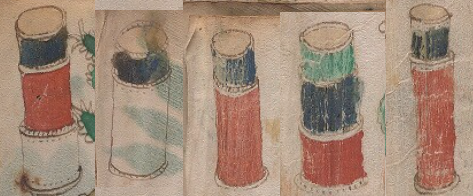
It’s difficult to tell if the VMS containers are tiered or telescoping. Tiered containers were not uncommon. And lensless sighting tubes were sometimes telescoping.
Sometimes a wooden layer was wrapped within leather or other materials and the ridge aligned with a cap. Containers were used for many purposes, so there were numerous variations in design.
There is a suggestion of a depression in the tops of some of the simpler containers.
Some of the simpler VMS containers look like they might be pigment tubes, scroll tubes, needle tubes, spice containers, or possibly even reading tubes. Some researchers have suggested weapons barrels for ones with reasonably straight shafts.
Summary
Maybe the VMS containers are documentary drawings, maybe they are designs or projections for something that would be difficult to craft until a decade or two later.
What I learned from looking at manuscript drawings is that many of the containers were reasonably accurate, but some were embellished beyond what was technologically feasible. I’m not sure which one applies to the VMS (especially since the VMS containers vary from simple to complex). The designs might be chosen to express a classification system for the plants, but given the practical nature of many of the tubes, perhaps they really existed.
J.K. Petersen
© Copyright 2 May 2020 J.K. Petersen, All Rights Reserved
